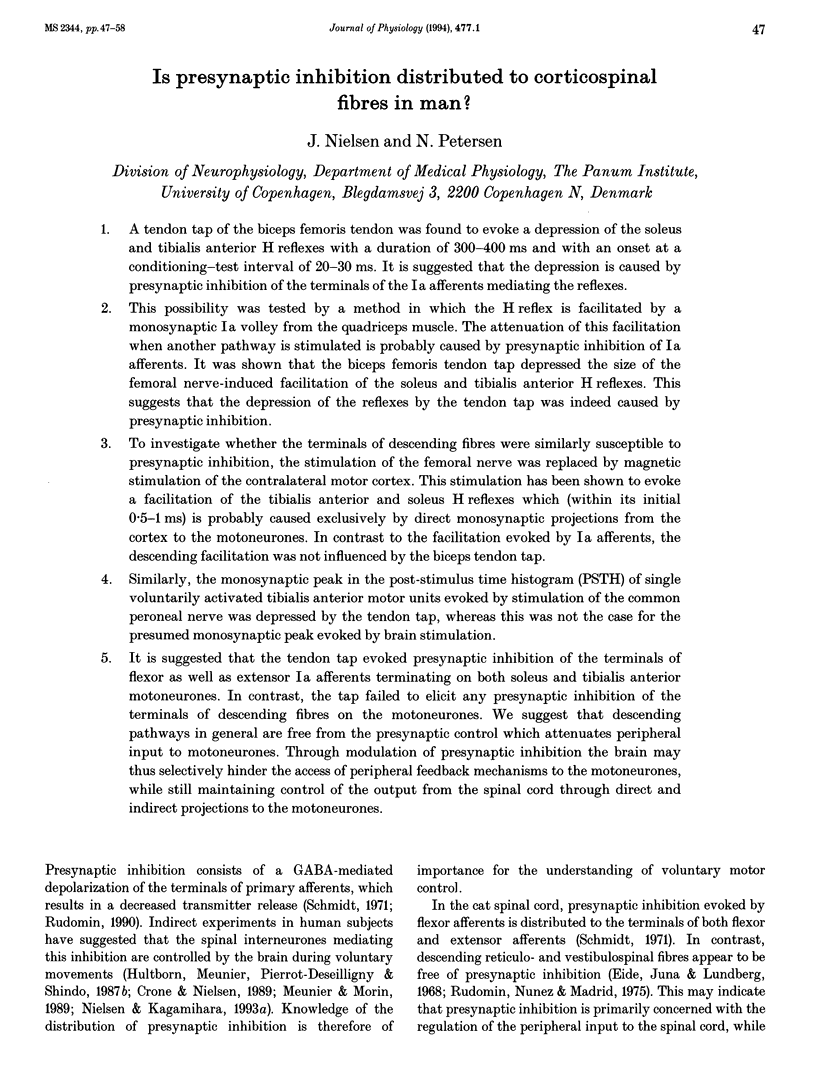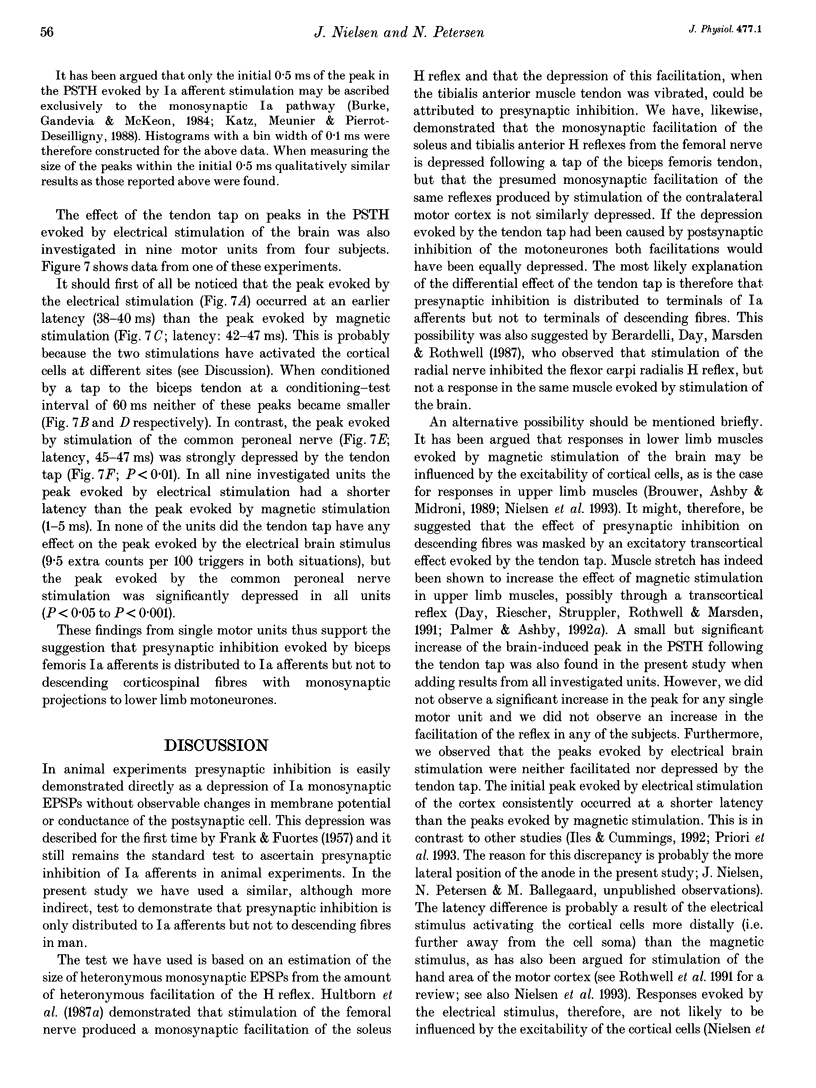Abstract
1. A tendon tap of the biceps femoris tendon was found to evoke a depression of the soleus and tibialis anterior H reflexes with a duration of 300-400 ms and with an onset at a conditioning-test interval of 20-30 ms. It is suggested that the depression is caused by presynaptic inhibition of the terminals of the Ia afferents mediating the reflexes. 2. This possibility was tested by a method in which the H reflex is facilitated by a monosynaptic Ia volley from the quadriceps muscle. The attenuation of this facilitation when another pathway is stimulated is probably caused by presynaptic inhibition of Ia afferents. It was shown that the biceps femoris tendon tap depressed the size of the femoral nerve-induced facilitation of the soleus and tibialis anterior H reflexes. This suggests that the depression of the reflexes by the tendon tap was indeed caused by presynaptic inhibition. 3. To investigate whether the terminals of descending fibres were similarly susceptible to presynaptic inhibition, the stimulation of the femoral nerve was replaced by magnetic stimulation of the contralateral motor cortex. This stimulation has been shown to evoke a facilitation of the tibialis anterior and soleus H reflexes which (within its initial 0.5-1 ms) is probably caused exclusively by direct monosynaptic projections from the cortex to the motoneurones. In contrast to the facilitation evoked by Ia afferents, the descending facilitation was not influenced by the biceps tendon tap. 4. Similarly, the monosynaptic peak in the post-stimulus time histogram (PSTH) of single voluntarily activated tibialis anterior motor units evoked by stimulation of the common peroneal nerve was depressed by the tendon tap, whereas this was not the case for the presumed monosynaptic peak evoked by brain stimulation. 5. It is suggested that the tendon tap evoked presynaptic inhibition of the terminals of flexor as well as extensor Ia afferents terminating on both soleus and tibialis anterior motoneurones. In contrast, the tap failed to elicit any presynaptic inhibition of the terminals of descending fibres on the motoneurones. We suggest that descending pathways in general are free from the presynaptic control which attenuates peripheral input to motoneurones. Through modulation of presynaptic inhibition the brain may thus selectively hinder the access of peripheral feedback mechanisms to the motoneurones, while still maintaining control of the output from the spinal cord through direct and indirect projections to the motoneurones.
Full text
PDF











Selected References
These references are in PubMed. This may not be the complete list of references from this article.
- Barker A. T., Jalinous R., Freeston I. L. Non-invasive magnetic stimulation of human motor cortex. Lancet. 1985 May 11;1(8437):1106–1107. doi: 10.1016/s0140-6736(85)92413-4. [DOI] [PubMed] [Google Scholar]
- Berardelli A., Day B. L., Marsden C. D., Rothwell J. C. Evidence favouring presynaptic inhibition between antagonist muscle afferents in the human forearm. J Physiol. 1987 Oct;391:71–83. doi: 10.1113/jphysiol.1987.sp016726. [DOI] [PMC free article] [PubMed] [Google Scholar]
- Brouwer B., Ashby P., Midroni G. Excitability of corticospinal neurons during tonic muscle contractions in man. Exp Brain Res. 1989;74(3):649–652. doi: 10.1007/BF00247369. [DOI] [PubMed] [Google Scholar]
- Burke D., Gandevia S. C., McKeon B. Monosynaptic and oligosynaptic contributions to human ankle jerk and H-reflex. J Neurophysiol. 1984 Sep;52(3):435–448. doi: 10.1152/jn.1984.52.3.435. [DOI] [PubMed] [Google Scholar]
- CURTIS D. R., ECCLES J. C. Synaptic action during and after repetitive stimulation. J Physiol. 1960 Feb;150:374–398. doi: 10.1113/jphysiol.1960.sp006393. [DOI] [PMC free article] [PubMed] [Google Scholar]
- Crone C., Nielsen J. Spinal mechanisms in man contributing to reciprocal inhibition during voluntary dorsiflexion of the foot. J Physiol. 1989 Sep;416:255–272. doi: 10.1113/jphysiol.1989.sp017759. [DOI] [PMC free article] [PubMed] [Google Scholar]
- Day B. L., Riescher H., Struppler A., Rothwell J. C., Marsden C. D. Changes in the response to magnetic and electrical stimulation of the motor cortex following muscle stretch in man. J Physiol. 1991 Feb;433:41–57. doi: 10.1113/jphysiol.1991.sp018413. [DOI] [PMC free article] [PubMed] [Google Scholar]
- Hultborn H., Meunier S., Morin C., Pierrot-Deseilligny E. Assessing changes in presynaptic inhibition of I a fibres: a study in man and the cat. J Physiol. 1987 Aug;389:729–756. doi: 10.1113/jphysiol.1987.sp016680. [DOI] [PMC free article] [PubMed] [Google Scholar]
- Hultborn H., Meunier S., Pierrot-Deseilligny E., Shindo M. Changes in presynaptic inhibition of Ia fibres at the onset of voluntary contraction in man. J Physiol. 1987 Aug;389:757–772. doi: 10.1113/jphysiol.1987.sp016681. [DOI] [PMC free article] [PubMed] [Google Scholar]
- Katz R., Meunier S., Pierrot-Deseilligny E. Changes in presynaptic inhibition of Ia fibres in man while standing. Brain. 1988 Apr;111(Pt 2):417–437. doi: 10.1093/brain/111.2.417. [DOI] [PubMed] [Google Scholar]
- Katz R., Morin C., Pierrot-Deseilligny E., Hibino R. Conditioning of H reflex by a preceding subthreshold tendon reflex stimulus. J Neurol Neurosurg Psychiatry. 1977 Jun;40(6):575–580. doi: 10.1136/jnnp.40.6.575. [DOI] [PMC free article] [PubMed] [Google Scholar]
- Kernell D., Hultborn H. Synaptic effects on recruitment gain: a mechanism of importance for the input-output relations of motoneurone pools? Brain Res. 1990 Jan 15;507(1):176–179. doi: 10.1016/0006-8993(90)90542-j. [DOI] [PubMed] [Google Scholar]
- Llewellyn M., Yang J. F., Prochazka A. Human H-reflexes are smaller in difficult beam walking than in normal treadmill walking. Exp Brain Res. 1990;83(1):22–28. doi: 10.1007/BF00232189. [DOI] [PubMed] [Google Scholar]
- Meunier S., Morin C. Changes in presynaptic inhibition of Ia fibres to soleus motoneurones during voluntary dorsiflexion of the foot. Exp Brain Res. 1989;76(3):510–518. doi: 10.1007/BF00248907. [DOI] [PubMed] [Google Scholar]
- Nielsen J., Kagamihara Y. Differential projection of the sural nerve to early and late recruited human tibialis anterior motor units: change of recruitment gain. Acta Physiol Scand. 1993 Apr;147(4):385–401. doi: 10.1111/j.1748-1716.1993.tb09515.x. [DOI] [PubMed] [Google Scholar]
- Nielsen J., Kagamihara Y. The regulation of presynaptic inhibition during co-contraction of antagonistic muscles in man. J Physiol. 1993 May;464:575–593. doi: 10.1113/jphysiol.1993.sp019652. [DOI] [PMC free article] [PubMed] [Google Scholar]
- Nielsen J., Petersen N., Deuschl G., Ballegaard M. Task-related changes in the effect of magnetic brain stimulation on spinal neurones in man. J Physiol. 1993 Nov;471:223–243. doi: 10.1113/jphysiol.1993.sp019899. [DOI] [PMC free article] [PubMed] [Google Scholar]
- Palmer E., Ashby P. Evidence that a long latency stretch reflex in humans is transcortical. J Physiol. 1992 Apr;449:429–440. doi: 10.1113/jphysiol.1992.sp019094. [DOI] [PMC free article] [PubMed] [Google Scholar]
- Palmer E., Ashby P. The transcortical nature of the late reflex responses in human small hand muscle to digital nerve stimulation. Exp Brain Res. 1992;91(2):320–326. doi: 10.1007/BF00231665. [DOI] [PubMed] [Google Scholar]
- Priori A., Bertolasi L., Dressler D., Rothwell J. C., Day B. L., Thompson P. D., Marsden C. D. Transcranial electric and magnetic stimulation of the leg area of the human motor cortex: single motor unit and surface EMG responses in the tibialis anterior muscle. Electroencephalogr Clin Neurophysiol. 1993 Apr;89(2):131–137. doi: 10.1016/0168-5597(93)90095-7. [DOI] [PubMed] [Google Scholar]
- Rothwell J. C., Thompson P. D., Day B. L., Boyd S., Marsden C. D. Stimulation of the human motor cortex through the scalp. Exp Physiol. 1991 Mar;76(2):159–200. doi: 10.1113/expphysiol.1991.sp003485. [DOI] [PubMed] [Google Scholar]
- Rudomin P., Jiménez I., Enriquez M. Effects of stimulation of group I afferents from flexor muscles on heterosynaptic facilitation of monosynaptic reflexes produced by Ia and descending inputs: a test for presynaptic inhibition. Exp Brain Res. 1991;85(1):93–102. doi: 10.1007/BF00229990. [DOI] [PubMed] [Google Scholar]
- Rudomin P., Solodkin M., Jiménez I. Synaptic potentials of primary afferent fibers and motoneurons evoked by single intermediate nucleus interneurons in the cat spinal cord. J Neurophysiol. 1987 May;57(5):1288–1313. doi: 10.1152/jn.1987.57.5.1288. [DOI] [PubMed] [Google Scholar]
- Rudomín P., Engberg I., Jiménez I. Mechanisms involved in presynaptic depolarization of group I and rubrospinal fibers in cat spinal cord. J Neurophysiol. 1981 Sep;46(3):532–548. doi: 10.1152/jn.1981.46.3.532. [DOI] [PubMed] [Google Scholar]
- Rudomín P., Jankowska E. Presynaptic depolarization of terminals of rubrospinal tract fibers in intermediate nucleus of cat spinal cord. J Neurophysiol. 1981 Sep;46(3):517–531. doi: 10.1152/jn.1981.46.3.517. [DOI] [PubMed] [Google Scholar]
- Rudomín P., Núez R., Madrid J. Modulation of synaptic effectiveness of Ia and descending fibers in cat spinal cord. J Neurophysiol. 1975 Sep;38(5):1181–1195. doi: 10.1152/jn.1975.38.5.1181. [DOI] [PubMed] [Google Scholar]
- Schmidt R. F. Presynaptic inhibition in the vertebrate central nervous system. Ergeb Physiol. 1971;63:20–101. doi: 10.1007/BFb0047741. [DOI] [PubMed] [Google Scholar]


